I’ve rebuilt several NiCd battery packs now, and all have been moderately successful. But all except the one I used all new cells for (Ed’s DeWalt) have surprised me with one cell failing way earlier than I’d like. Humpf.
Now that I’ve gotten my feet wet a little with LiPos and learned that the catching fire, being incredibly sensitive to charging protocol etc are pretty much addressed if you use an actual LiPo charger, and that except for the charging rate the chargers are all pretty interchangeable, it has occurred to me that maybe I should bump some of my devices up to this new, high energy/weight ratio technology. Volts is volts and amps is amps, so the device motors don’t know or care what battery technology is providing the power. And from the various NiCd rebuilds, I just happen to have some spare battery cases I can hack to house a LiPo.
The RC aircraft/car industry has made a great variety of high power LiPos available at reasonable cost. I just bought a 3300 mA-hr 18.5V battery rated at 40C discharge (that’s > 120 amps!), along with a nice, flexible charger. That 3300 mA-hr rating is about double what most NiCd sub-Cs will deliver – and the battery pack is smaller and lighter.
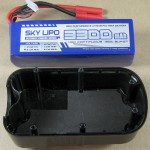
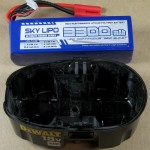 Of course it’s a different shape, so some moderate container hacking will be needed to make something that will plug into my two target devices. You can see it won’t quite fit in the cases for either the B&D blower battery or an 18V DeWalt pack. In choosing that big honker I realized the great capacity would come at a cost of ugly packaging.
Of course it’s a different shape, so some moderate container hacking will be needed to make something that will plug into my two target devices. You can see it won’t quite fit in the cases for either the B&D blower battery or an 18V DeWalt pack. In choosing that big honker I realized the great capacity would come at a cost of ugly packaging.
 For this first foray into big LiPos, I only have one battery, so I got some extra mating connectors so I can swap it easily between the B&D and DeWalt cases. I guess the cool kids use Anderson PowerPole connectors, but this battery already had 4 mm banana connectors, and HobbyPartz had the mating ones pretty cheap. And the online support chat person was able to tell me that I needed the 34 mm long ones rather than the nearly identical 30 mm long ones. (Who knew?)
For this first foray into big LiPos, I only have one battery, so I got some extra mating connectors so I can swap it easily between the B&D and DeWalt cases. I guess the cool kids use Anderson PowerPole connectors, but this battery already had 4 mm banana connectors, and HobbyPartz had the mating ones pretty cheap. And the online support chat person was able to tell me that I needed the 34 mm long ones rather than the nearly identical 30 mm long ones. (Who knew?)
But even more than needing to unplug the battery to swap cases, I’ll need to unplug it to 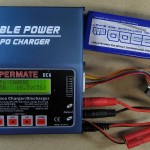 charge it. Unlike the crude two-wire connection to a series block of NiCds, high performance series LiPos also have balancing connectors that provide separate connections for each cell. While the bulk of the charging current still goes through the main connections to the very outside cells, the balancing connections allow a smart charger to adjust the charge current to each cell independently. You don’t just plop these puppies into a hole in a charger anymore! Here’s this one set up to charge. (Yeah, one of the charging adapters has silly thin wires for this application.) Since the charger can deal with batteries with from one to six cells in series (1S-6S), it has a little breakout panel to connect a variety of balancing connector widths. Yes, I realize this will make for pretty inconvenient charging, but I’m hoping the extended run time will be worth it. We’ll see.
charge it. Unlike the crude two-wire connection to a series block of NiCds, high performance series LiPos also have balancing connectors that provide separate connections for each cell. While the bulk of the charging current still goes through the main connections to the very outside cells, the balancing connections allow a smart charger to adjust the charge current to each cell independently. You don’t just plop these puppies into a hole in a charger anymore! Here’s this one set up to charge. (Yeah, one of the charging adapters has silly thin wires for this application.) Since the charger can deal with batteries with from one to six cells in series (1S-6S), it has a little breakout panel to connect a variety of balancing connector widths. Yes, I realize this will make for pretty inconvenient charging, but I’m hoping the extended run time will be worth it. We’ll see.
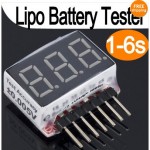 I really don’t want to abuse/over-discharge this nice new battery and the devices can’t provide any warnings, so I need some way to monitor the voltage while I’m using the devices. The RC industry (and Ebay) came to the rescue again with this $3 multi-cell monitor/meter. It plugs into the balancing connector so it can report on each cell. It will add even more ugly to the packaging to have this thing stuck on the outside of the battery case, but at least until I get a feel for how the devices perform, I’ll feel better knowing the voltages.
I really don’t want to abuse/over-discharge this nice new battery and the devices can’t provide any warnings, so I need some way to monitor the voltage while I’m using the devices. The RC industry (and Ebay) came to the rescue again with this $3 multi-cell monitor/meter. It plugs into the balancing connector so it can report on each cell. It will add even more ugly to the packaging to have this thing stuck on the outside of the battery case, but at least until I get a feel for how the devices perform, I’ll feel better knowing the voltages.
Updates to follow as I actually hack up some battery cases.
Update 8/15/12: I use the blower to clean up after I cut the grass, and I had to cut the grass, so I had to somehow get the blower running. (OK, I could have used the one remaining NiCd pack, but what fun is that?)
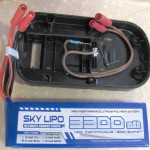 It was thinner than ideal, but I used some 18 gauge zip cord to make a little pigtail from the connectors in the top of a battery case to my now-standard polarized 4 mm banana plugs. The metal insides snap into the connector shells from the outside, so the wire has to thread thru the shell before soldering it to the contact. Requires a little extra splitting for use with zip cord, but it’s OK.
It was thinner than ideal, but I used some 18 gauge zip cord to make a little pigtail from the connectors in the top of a battery case to my now-standard polarized 4 mm banana plugs. The metal insides snap into the connector shells from the outside, so the wire has to thread thru the shell before soldering it to the contact. Requires a little extra splitting for use with zip cord, but it’s OK.
Time was short, so I didn’t hack the case. There’s some kind of  slot/rail that holds the top of the case in the blower, so that was all I really needed. I put some padding in and strapped the battery in with some velcro. Really crude, but pretty effective.
slot/rail that holds the top of the case in the blower, so that was all I really needed. I put some padding in and strapped the battery in with some velcro. Really crude, but pretty effective.
The battery has never been used, and I assume it was shipped in 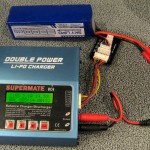 the customary 50% charged “storage” state, so I needed to juice it up before I used the blower. Cleverly fitting the battery holding stuff first, there was now a nice time window to charge it while I cut the grass. I was going to leave the charging setup unattended (generally a poor practice with LiPos), so at least I put it on a fireproof surface (the stove top).
the customary 50% charged “storage” state, so I needed to juice it up before I used the blower. Cleverly fitting the battery holding stuff first, there was now a nice time window to charge it while I cut the grass. I was going to leave the charging setup unattended (generally a poor practice with LiPos), so at least I put it on a fireproof surface (the stove top).
It’s a 50W charger, and the battery is 3300 mA-hr, so I chose a conservative 0.63 C charge rate of 2.1A to stay within the charger’s specs. The charger has a fan, but understandably it was getting warm. Just to be nice I put another little table fan on the whole setup. When I came in after the grass was cut, the display indicated “Full”. It had defaulted to 4.2V/cell, so it was reading just about 21V. I don’t know if it does a much lower current at that point or just shuts off.
When I ran the blower, it was louder and higher pitched – and more effective – than I’d become accustomed to with its less-than-new NiCd pack. I did my normal cleanup routine and at the end it was still going like when I first turned it on. The zip cord pigtail was noticeably warm, but the battery was cold. When I got it back inside it was down to 20.2V no load, so I’d hardly put a dent in it. Crude packaging, but a fully successful first conversion!
Update 8/23/12: I cut the grass again today and used the blower with the LiPo. I hadn’t recharged it after the last use. It was still 18.6V no load when I was done this time. Nice battery capacity!
Update 8/31/12: I cut the grass again and used the blower again – still without recharging it after the first time – and it ran fine and still read ~18.2V afterward! That’s 3 uses on one charge. I used to go through both my 18V NiCd packs for each cleanup. This battery is great.
 The little 6S voltmeter came a little while ago. It was very nice to have this “fuel gauge” to see how the battery was doing as I was using the blower today. The balancing connector on the battery has one red and 5 black wires. The voltmeter is marked + and – at the ends. If I let the + end hang out over the connector end with the red wire, it works. After it boots up, it loops, displaying “ALL, <voltage>, No1,<voltage>,No2 …” Works fine. I connected just the – end and the first adjacent pin to a 12V (lead/acid) battery and it displayed the battery voltage nicely.
The little 6S voltmeter came a little while ago. It was very nice to have this “fuel gauge” to see how the battery was doing as I was using the blower today. The balancing connector on the battery has one red and 5 black wires. The voltmeter is marked + and – at the ends. If I let the + end hang out over the connector end with the red wire, it works. After it boots up, it loops, displaying “ALL, <voltage>, No1,<voltage>,No2 …” Works fine. I connected just the – end and the first adjacent pin to a 12V (lead/acid) battery and it displayed the battery voltage nicely.
